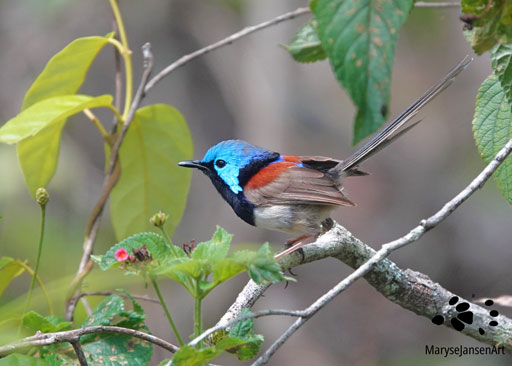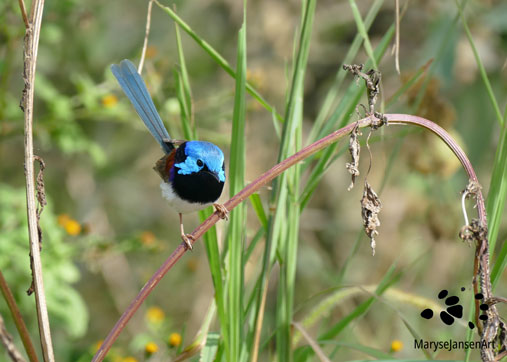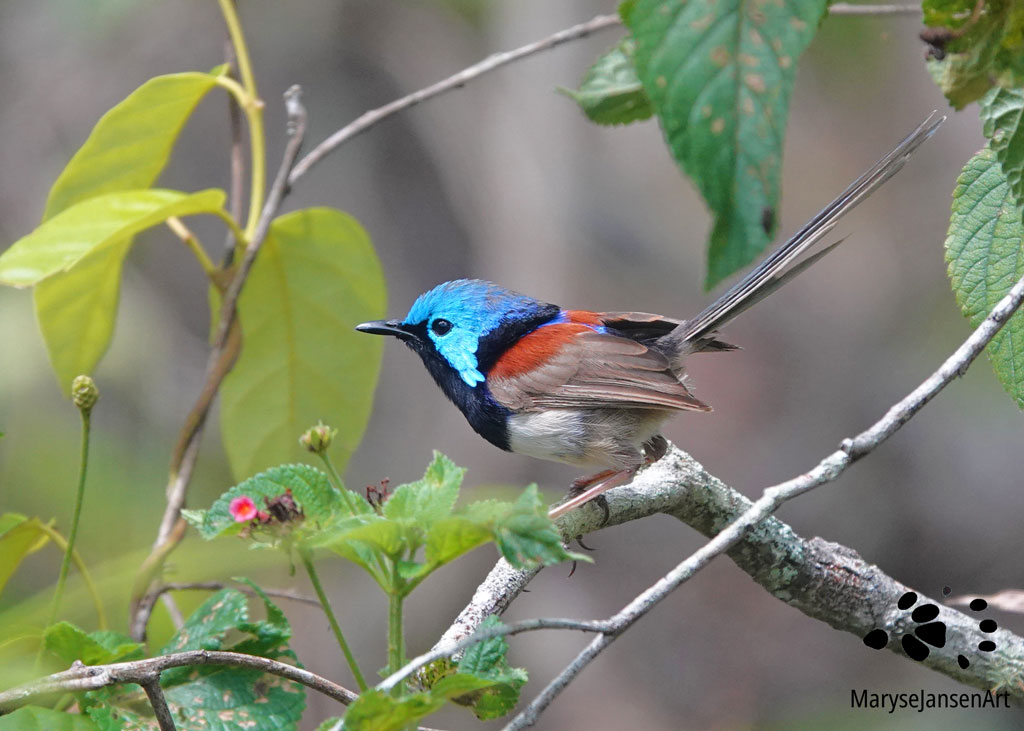Bird Photography with marysejansenart
A close-up look at the male Variegated Fairy-wren

It takes a bit of effort not to get frustrated… Every time the little bird sits down I try to get my camera to quickly focus for the shot, but most of the time the bird is already gone before I can blink an eye. And that is when I’m lucky enough to even get it close up in my view finder before it hides behind the bushes again! Variegated Fairy-wrens are tiny, restless and fast! It is a real challenge to get a good photo!
A challenge it may be, but I’m up for it, because they are stunningly beautiful!
Table of Contents
Variegated Fairy-wren species revised
Fairy-wrens are probably one of the most depicted birds of Australia. Their beautiful colours and cute, upright tails have made them very popular. There are 9 species of Fairy-wrens in Australia. The Variegated Fairy-wren was long thought to be the most widespread species, covering most of Australia with its 4 subspecies. A lot of resources will still tell you this is true. However, in 2018 the IOC World Bird List (International Ornithologists Union) revised this.
The Purple-backed Fairy-wren was recognised as a separate species, covering much of the continent. This now leaves the Variegated Fairy-wren only to roam a part of eastern Australia, along the coast of most of New South Wales as well as south-east Queensland. My photos were taken in south-east Queensland and depict, indeed, a Variegated Fairy-wren!
Tiny and hidden
These birds are in the books as a 15cm sized bird, but as this is measured from their bill tip to the tip of the tail, that is mostly due to their long tail. They are really very tiny birds.
Variegated Fairy-wrens spend their time foraging for insects and seeds on the ground or in the understorey. They love bushes and thickets as these gives them protection. They will rarely venture out in the open. This is one of the reasons why it is so difficult to get a clear shot of them. There is almost always a branch in the way.
Chirpy chatter
They live in social groups and communicate with each other through a soft chirping sound. I usually find them by tuning my ears to their call. As soon as I hear their chirpy chatter in the foliage next to the track I’m walking on, I stop and take a closer look. During their foraging the group moves along continuously, always hopping and bouncing from one branch to the next or taking short flights. So I listen for their call and then look for movement in the thickets.
Seeing them can often be a very short-lived experience as they continuously move along in search of food. Also, they are easily alarmed by movement and know how to quickly hide from potential danger. Therefore it is important to stand really still when trying to observe or photograph these birds. It’s a matter of trying my luck at every opportunity and sometimes, when I do stand very still, they seem to forget I am there and show themselves in a bit closer range.
Look at me! The male Variegated Fairy-wren in his breeding plumage
Bingo! I know this is going to be a clear shot! The beautiful male sits momentarily on that bowed twig and I’m ready for him! He looks so proud. Like he’s really showing off his beautiful plumage, saying ‘Look at me!’

When you look at a group of Variegated Fairy-wrens you might think that the colourful male has a harem of females. This is not the case. The social group consists of a dominant male and female and furthermore juveniles and non-breeding birds. Non-breeding males, females and juveniles all look very similar with mostly a grey-brown colouring. When the male comes into breeding-season he develops his stunning breeding-plumage.
The throat/chest area and the nape (back of the neck) turn black, the shoulders a deep chestnut, the tail bluish-grey and the belly creamy white. But the most striking are the iridescent blue head and ear-tufts!
The breeding-season is from spring to late summer. All the birds in the group help raise the 3-4 young. After the breeding season the male moults back into his non-breeding plumage.
Variegated Fairy-wren Splendour
I never get enough of the challenge. Even though I have some good shots I’m always on the lookout for more. I really enjoy observing these little birds!
Today I’m in luck as well. A number of breeding males are hopping around the bushes, accompanied by the other birds in their groups. As the light hits the iridescent blue feathers they shine so beautifully and in a fraction of a second I get the opportunity to shoot ‘Variegated Fairy-wren Splendour’! In this profile shot you get an even better look at all the different colours he’s displaying.
If you are interested in purchasing ‘Variegated Fairy-wren Splendour’ or would like to see what the image looks like on the various products, please head to my shop. If you prefer ‘Look at me!’ then click shop here.
Fairy-wren Bird Photography Tips
- Learn about their habitat so you know where you can find them;
- Tune your ears to their call, it will help you detect where they are;
- Tune your eyes to their movements, it’s hard to spot them in the dense undergrowth but movement gives them away;
- Be very, very still, they are easily alarmed by your movements and will disappear quickly at any sign of danger;
- Be ready to shoot as they move very fast.
For more Bird Photography Tips, check out Pale-headed Rosella in the Spotlight.


